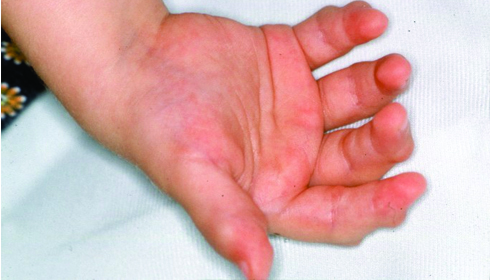
Farber disease
Lysosomal storage illnesses include the very rare hereditary condition known as Farber disease, sometimes referred to as Farber lipogranulomatosis. First reported by Sidney Farber in 1957, this illness is typified by a lack of an enzyme known as acid ceramidase, which causes a fatty substance called ceramide to accumulate in several tissues all across the body. The accumulation of ceramide, which usually affects the joints, lungs, liver, and central nervous system, causes a range of symptoms.
Factors and genetic background
Farber disease is caused by mutations in the ASAH1 gene, which codes for the enzyme acid ceramidase. This enzyme produces both sphingosine and fatty acid from ceramide, which is important for cell membrane integrity and signaling cascades. A mutant ASAH1 gene results in either the absence or a significant decrease in enzyme activity, which causes the pathogenic accumulation of ceramide.
Following an autosomal recessive inheritance pattern, the disease requires two copies of the defective gene—one from each parent—for a child to acquire it. Typically, carriers who carry one copy of the mutant gene are asymptomatic.
Forms and signs
The degree and age of development of Farber illness frequently define the various forms it might take:
Types 2 and 3 are more severe, with an earlier start and more marked neurological involvement. Symptoms could consist of:
A more rapid development of illness leads to a shorter life expectancy.
Less prevalent Type 4 and other atypical forms usually have milder symptoms, with a later start and less marked musculoskeletal or neurological involvement.
Diagnosis
Because Farber disease is rare and its symptoms vary, diagnosis can be difficult. However, the following symptoms typically contribute to the diagnosis:
Clinical examination: a thorough evaluation of symptoms, especially hoarseness, joint stiffness, and subcutaneous lumps.
Measuring the activity of acid ceramidase in blood leukocytes or cultured skin fibroblasts is known as an enzyme assay. Less or none of the activity validates the diagnosis.
Molecular genetic testing helps one find mutations in the ASAH1 gene. For carriers, this can confirm diagnosis and aid family planning.
Treatment and Control: Management
Currently, there is no cure for Farber disease; instead, treatment focuses on managing symptoms and enhancing quality of life. The strategy could consist of:
Prospective
Depending on the type and intensity, Farber disease has rather different chances. In severe cases (such as Type 2 or 3), early childhood can be fatal for the illness. Though they sometimes come with major physical and neurological difficulties, milder types of the disease could provide a longer life expectancy.
Individuals affected by the complicated and rare hereditary condition known as Farber disease face significant challenges. Early diagnosis and supportive treatment are critical for managing symptoms and improving patient quality of life. Genetic studies and possible treatments have the potential to improve treatment choices in the future. Knowing about this rare illness increases the likelihood of discovering more efficient approaches to fighting it.